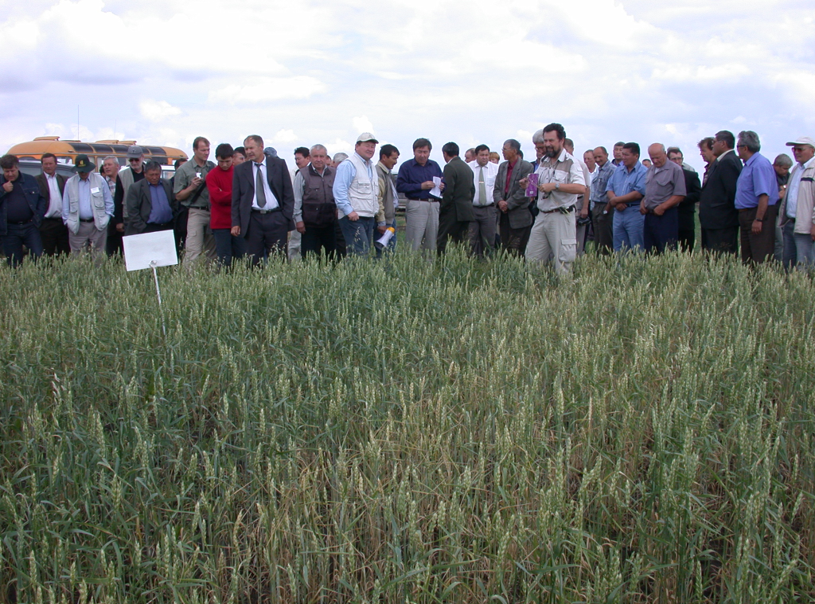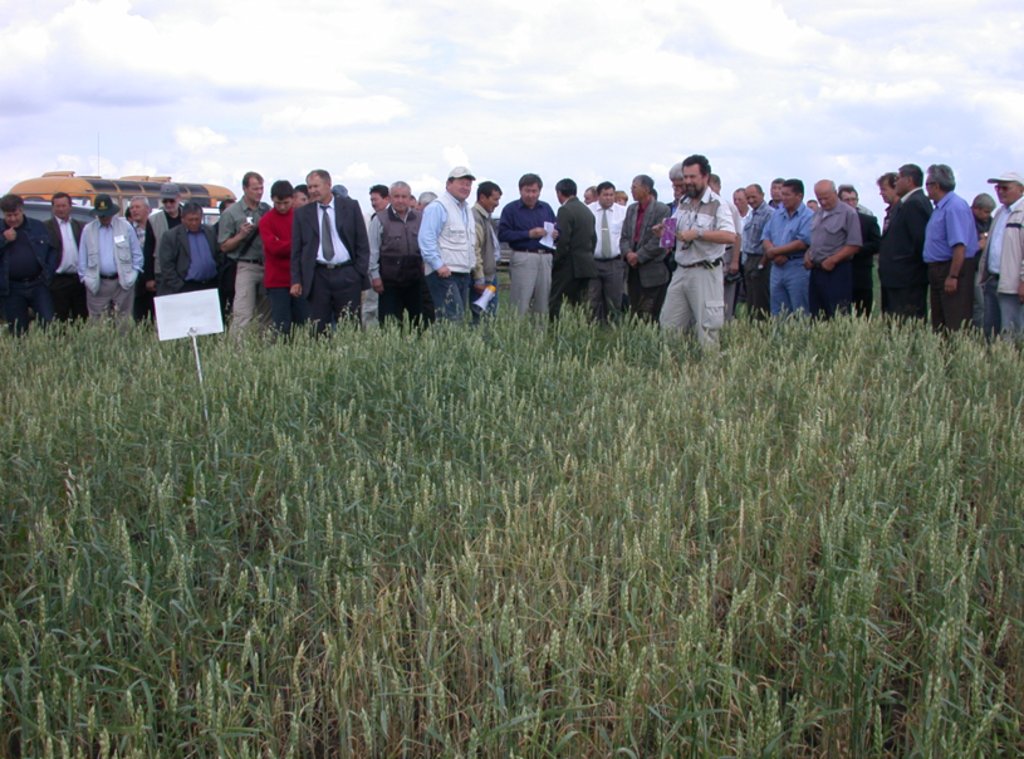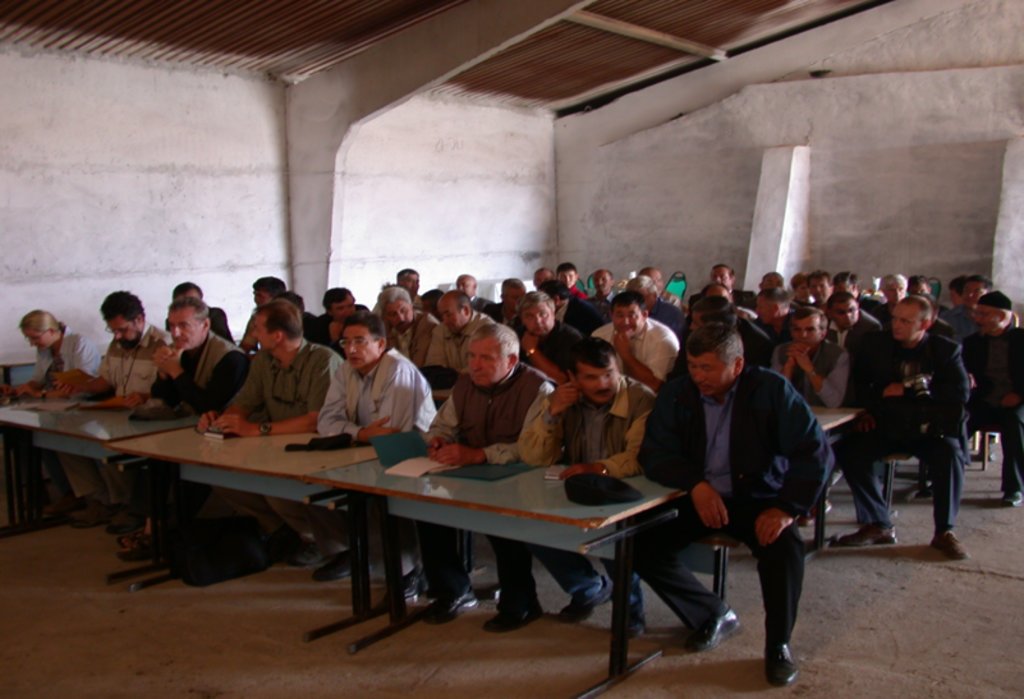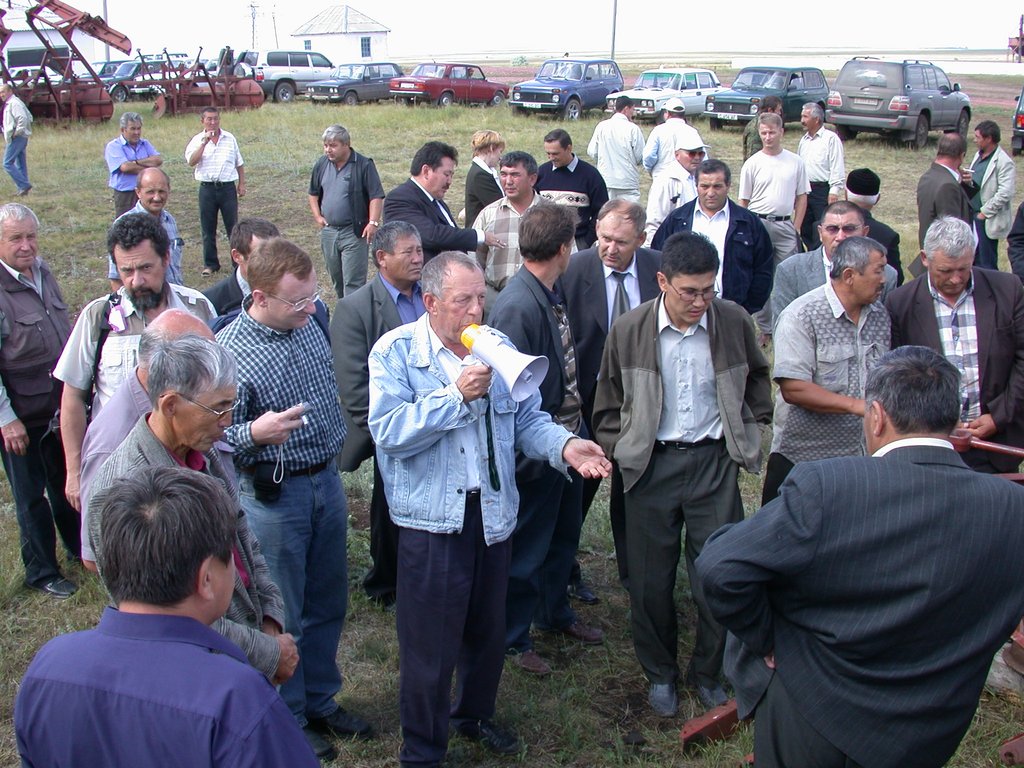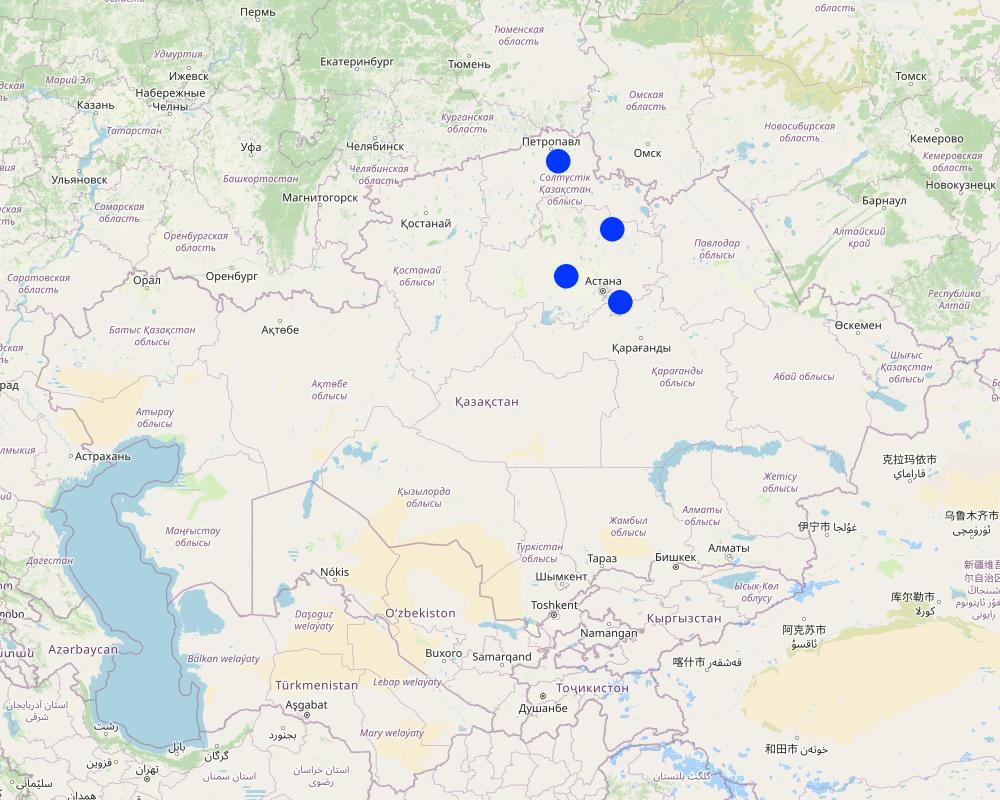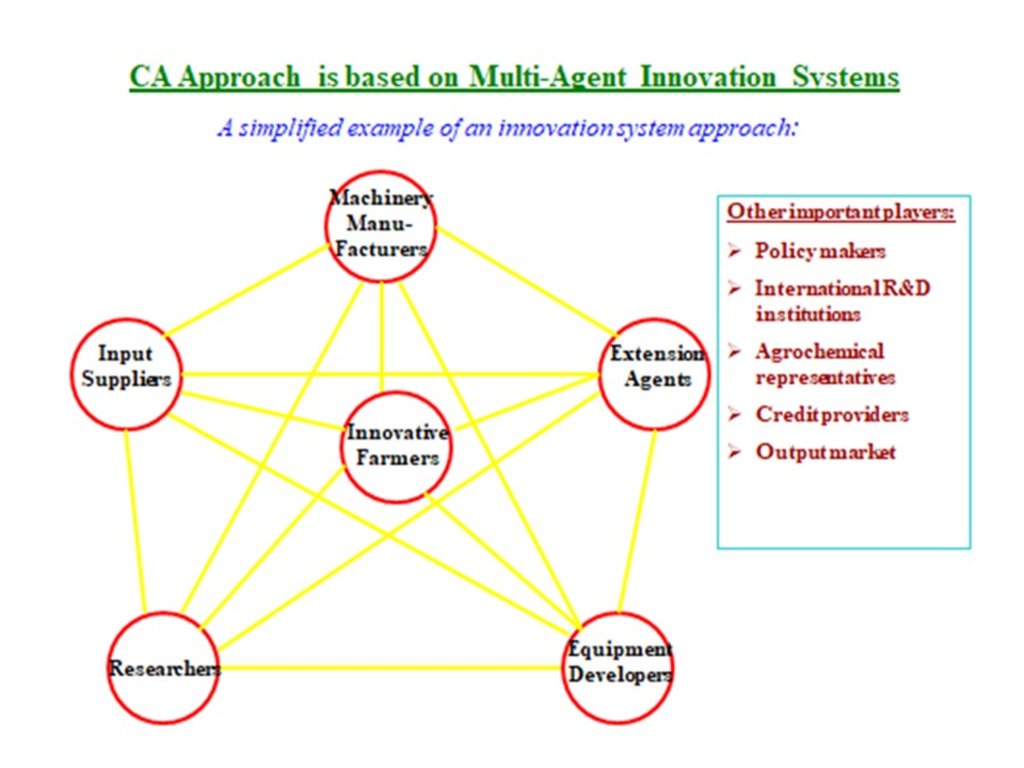Awareness Raising for SLM Using Conservation Agriculture [Cazaquistão]
- Criação:
- Atualização:
- Compilador/a: Kulyash Iskandarova
- Editor: Hayot Ibrakhimov
- Revisor: Rima Mekdaschi Studer
Awareness and knowledge on Conservation Agriculture for rainfed crop production
approaches_5677 - Cazaquistão
Veja as seções
Expandir tudo Recolher tudo1. Informação geral
1.2 Detalhes do contato das pessoas capacitadas e instituições envolvidas na avaliação e documentação da abordagem
Pessoa(s) capacitada(s)
expert/consultant:
Karabayev Muratbek
+7 (7172) 34 37 13 / +7 (701) 216-77-21
m.karabayev@cgiar.org / muratbek.karabayev@gmail.com
International Maize and Wheat Improvement Center (CIMMYT), CIMMYT-Kazakhstan
Office #7, B.Maylin str., 10, Astana, 010000, Kazakhstan
Cazaquistão
Nome do projeto que facilitou a documentação/avaliação da Abordagem (se relevante)
Integrated natural resources management in drought-prone and salt-affected agricultural production landscapes in Central Asia and Turkey ((CACILM-2))Nome da(s) instituição(ões) que facilitou(ram) a documentação/avaliação da Abordagem (se relevante)
Kazakh Research Institute for Livestock and Fodder Production (Kazakh Research Institute for Livestock and Fodder Production) - Cazaquistão1.3 Condições em relação ao uso da informação documentada através de WOCAT
Quando os dados foram compilados (no campo)?
02/02/2020
O/a compilador/a e a(s) pessoa(s) capacitada(s) aceitam as condições relativas ao uso de dados documentados através da WOCAT:
Sim
1.4 Referência ao(s) questionário(s) sobre tecnologias da GST
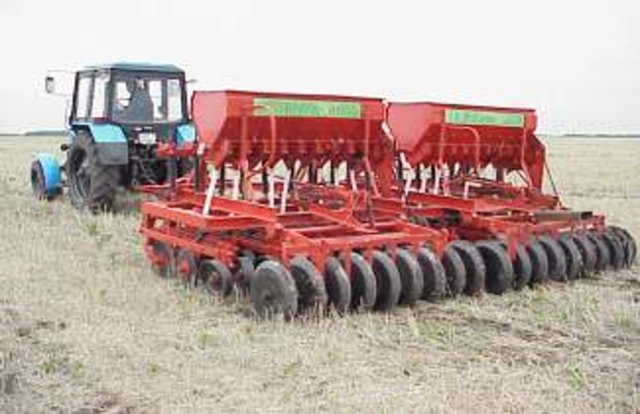
Conservation Agriculture for cereal production in rainfed areas … [Cazaquistão]
Conservation agriculture applied in Northern Kazakhstan is based on no-tillage direct sowing of cereals into the soil permanently covered by crop residues. It contributes to reverse soil degradation, enhance water use efficiency, increase crop productivity in the rainfed lands.
- Compilador/a: Kulyash Iskandarova
2. Descrição da abordagem de GST
2.1 Descrição curta da abordagem
Raising awareness and strengthening the capability and skills of farmers, agriculture specialists and researchers in developing and adoption resource-saving, profitable and environmentally friendly cereal production through Conservation Agriculture practices.
2.2 Descrição detalhada da abordagem
Descrição detalhada da abordagem:
The main features of the approach:
•Empower farmers to become self-sufficient in managing their lands under Conservation Agriculture through education, awareness raising with a focus on transferring knowledge, skills and tools to improve crop production, increase food security, and incomes of rural communities.
•Promote the transition from traditional farming to modern systems based on minimal soil treatment, diversified crop production, stubble retention and direct seeding by building capacity.
•Facilitate positive change by leveraging the strengths and capabilities of different partners to transfer skills, knowledge and resources to farmers and communities interested in active CA adoption.
In Kazakhstan the most of crop management experiences and education in universities emphasized conventional tillage based production systems. Changing minds to accept crop management practices based on the principles of Conservation Agriculture is one of the biggest constraint of CA adoption. Farmers are ready to change their mind set if they are knowledgeable, well informed and see the benefits of CA-based crop management practices in their fields. The approach is based on awareness raising, training of farmers and farmer testing of CA technology in close collaboration with specialists from international and local institutions. An active dialogue with farmers, knowledge and technology dissemination are built on participation of qualified specialists/experts who are part of the management team of each farm and are able to efficiently test and adapt new technologies to the local conditions. CA is a complex approach and system, it implies changes in a number of technological components of the existing traditional systems of agriculture. It is necessary to change two basic paradigms: the paradigm of soil tillage and the paradigm of linear knowledge flow.
Many agricultural research and extension systems are based on a linear model of knowledge flow, with new knowledge being developed in research organizations, passed on to agricultural extension agents who in turn pass on the new knowledge and information to farmers. While this model may be applied to simple technology, it does not always effectively work with complex technologies, especially when research institutes do not have the capacity to develop functional packages of multiple technological components for all farmer situations. Innovative approaches on the basis of complex technologies are needed in adaptation, system development process and promotion. Innovative approach (platforms) are based on networks of multiple agents, including farmers-innovators and decision-makers, all utilizing their own knowledge, external information and policy support to help overcome problems and develop functional systems for local farming conditions and farmer circumstances.
The target farmers as well as farmers of the neighbouring farming community were trained on-the-job on key topics of CA such as diversified cropping systems, chemical fallow, minimum/no-tillage, direct seeding, and snow and residue management. Altogether four training workshops were carried out. In each session international and national experts trained about 30 farmers. Conservation Agriculture study tour to USA (Washington State, Idaho State) and Canada (Saskatchewan Province) was organized. Public awareness and also training on CA-technology also were generated through six field days and seminars bringing together farmers, stakeholders, policy-makers and researchers to observe and discuss key field demonstrations.
Large-scale adoption of Conservation Agriculture (zero/minimum soil tillage, leaving crop residues in the fields, direct seeding with narrow chisel and disk openers, permanent bed-planting and furrow irrigation, etc.) were initiated by the International Maize and Wheat Improvement Center (CIMMYT) and FAO in 2002. Thanks to the joint efforts of national scientists and farmers, international organizations (CIMMYT, FAO, ICARDA, World Bank, UNDP, USAID, etc.), support by the state and government bodies, the areas under no-till have been increasing from virtually none in 2002 to an estimated area of 3 000 000 ha in 2019.
2.3 Fotos da abordagem
2.4 Vídeos da abordagem
Comentários, breve descrição:
Not available
2.5 País/região/locais onde a abordagem foi aplicada
País:
Cazaquistão
Região/Estado/Província:
Northern Kazakhstan: Akmola and North Kazakhstan regions (provinces)
Comentários:
CA approaches and principles are not site specific and can be applied to essentially all crop production systems.
1) Farm “Cherezdanov”, Smirnovo village, Akkayinskii district, Northern Kazakhstan region, located approximately 60 kilometers south of Petropavlovsk and 700 km from Astana (Nur-Sultan). The farm Head is Vyacheslav Cherezdanov.
2) Farm “Daryn”, Valikhanovo village, Zharkainsky district, Akmola region, located approximately 600 kilometers southwest of Astana (Nur-Sultan). The Head is Auezkhan Darynov.
3) Farm “Dostyk 06”, Astrahanovka village, Astrahanskyi district, Akmola region, located approximately 110 kilometers west of Astana (Nur-Sultan). The Head is Meyram Sagimbayev.
4) Farm “Surayev”, Vishnevka village, Arshalinsky district, Akmola region, located approximately 60 kilometers south of Astana (Nur-Sultan). The Head is Viktor Surayev.
Map
×2.6 Datas de início e término da abordagem
Indique o ano de início:
2002
Ano de término (caso a abordagem não seja mais aplicada):
2004
Comentários:
CA system approach continues adoption in the Kazakhstan and Eurasia region
2.7 Tipo de abordagem
- Baseado em projeto/programa
2.8 Principais metas/objetivos da abordagem
Improve knowledge, raising awareness, enhance capability of farmers, agriculture specialists and different partners in using CA-farming practices for a more sustainable and profitable crop production in rainfed lands of Kazakhstan
2.9 Condição que propiciam ou inibem a implementação de tecnologia/tecnologias aplicada(s) segundo a abordagem
Colaboração/coordenção de atores
- Propício
The CA approach is based on collaboration and network of multiple agents and actors (farmers-innovators, decision-makers, national and international institutions, researchers, experts, etc.) to enable and help overcome problems and develop functional systems for local farming conditions and farmer circumstances.
Conhecimento sobre GST, acesso a suporte técnico
- Propício
•Knowledge of weed control: Options for weed control with different weed spectra and these different conditions must be available.
•Knowledge of crop rotations incorporating species profitable for farming, demanded by the market, tolerant to dry conditions and enriching soil, e.g. legumes.
•Knowledge and information about the CA equipment most appropriate for use in the country conditions are significant factor in the spread and successful management of CA, especially direct seeders, sprayers for uniform herbicide application and straw spreaders for the combine harvesters.
3. Participação e papel das partes interessadas envolvidas
3.1 Partes interessadas envolvidas na abordagem e seus papéis
- Usuários de terra/comunidades locais
1) A.Darynov, “Daryn” Farm, Valikhanovo village, Zharkainsky district, Akmola region, Kazakhstan
2) M.Sagimbayev, “Dostyk06” Farm, Astrahanovka village, Astrahanskyi district, Akmola region, Kazakhstan
3) V.Surayev, “Surayev” Farm, Vishnevka village, Arshalinskyi district, Akmola region, Kazakhstan
4) V.Cherezdanov, “Cherezdanov” Farm, Smirnovo village, Akkayinskii district, Northern Kazakhstan region, Kazakhstan
Coordination of field works, adoption at the farm
- Especialistas em GST/ consultor agrícola
1) Dr.M.Matyushkov, Research and Production Center of Grain Farming, Shortandy, Akmola region, adviser in agriculture equipment
2) Dr.I.Vasko, Research and Production Center of Grain Farming, Shortandy, Akmola region, adviser in agronomy and economics
1) Adoption of CA equipment at farms
2) Assessment of CA technology effectiveness
- Pesquisadores
1) Dr.A.Bektemirov, Research and Production Center of Grain Farming, Shortandy, Akmola region, consultant on soil science
2) Dr.A.Kenjebekov, Research and Production Center of Grain Farming, Shortandy, Akmola region, consultant on agronomy
1) Soil investigations and analysis
2) Agronomy research and analysis
- Governo nacional (planejadores, responsáveis pelas decisões)
Prof.K.Elemesov, Ministry of Agriculture of the Republic of Kazakhstan, Head of Science Department, National Project Coordinator
Coordination of the CA adoption project on behalf of the government of the Republic of Kazakhstan
- Organização internacional
1) Dr.Th,Bachmann, FAO Specialist on Agronomy
2) Dr.Th.Friedrich, FAO Specialist on Engineering
3) Prof. M.Karabayev, CIMMYT Representative in Kazakhstan
1) Consultations on agronomy issues of the CA technology adoption
2) Consultations on engineering issues of the CA technology adoption
3) The Project Leader
- Foreign organization
Prof. L. Makus, Professor of Economics, Idaho State University, USA
Economic research and assessment of CA adoption at farms
Caso várias partes interessadas foram envolvidas, indique a agência líder:
The lead Agency - Ministry of Agriculture of the Republic of Kazakhstan
3.2 Envolvimento do usuários de terra/comunidades locais nas diferentes fases da abordagem
| Envolvimento do usuários de terra/comunidades locais | Especifique quem estava envolvido e descreva as atividades | |
|---|---|---|
| Iniciação/motivação | Passivo | Farmers involved in the project realization participated at the different seminars on CA technologies and innovations in land management organized by international institutions (FAO, CIMMYT) |
| Planejamento | Participativo | Definition of the most appropriate (location, size) lands, needs in labour, equipment, technique support for the project trials. |
| Implementação | Participativo | Organization, manage and control field works. |
| Monitoramento/avaliação | Participativo | Active participation and assistance to the project consultants in monitoring and evaluation processes. |
3.3 Fluxograma (se disponível)
Descrição:
Conservation Agriculture Innovative approach (platform) is based on networks of multiple agents, including farmers-innovators and decision-makers, all utilizing their own knowledge, external information and policy support to help overcome problems and develop functional systems for local farming conditions and farmer сircumstances
Autor:
M. Karabayev
3.4 Decisão sobre a seleção de tecnologia/tecnologias de GST
Especifique quem decidiu sobre a seleção de tecnologia/tecnologias a serem implementadas:
- todos os atores relevantes, como parte de uma abordagem participativa
Explique:
Innovative approach on the basis of complex technologies, like Conservation Agriculture, is needed in adaptation, system development process, comprehensive assessment and promotion. That is why and main reason of all relevant actors participate in decision making on the selection of the technology
Especifique em que base foram tomadas as decisões:
- Avaliação de conhecimento bem documentado de GST (tomada de decisão baseada em evidências)
- Resultados de pesquisa
- Experiência pessoal e opiniões (não documentado)
4. Suporte técnico, reforço das capacidades e gestão do conhecimento
4.1 Reforço das capacidades/ formação
Foi oferecida formação aos usuários da terra/outras partes interessadas?
Sim
Especifique quem foi capacitado:
- Usuários de terra
- Equipe de campo/consultores
Tipo de formação:
- Agricultor para agricultor
- Áreas de demonstração
- Reuniões públicas
Assuntos abordados:
“Conservation Agriculture for rainfed crop production”, “Conservation Agriculture for irrigated crop production”
Comentários:
An important factor of wide-scale extension of CA is training and introduction of farmers and specialists with the new innovations and approaches, on-farm demonstration of technology components, expertise of foreign specialists, and wide public awareness activities. As a total, 12 different project events (workshops, training seminars, field days, study tours for farmers and specialists, consultations, lectures and methodological assistance provided by foreign specialists and scientists, etc.) were conducted. The implementation process of the project was regularly highlighted in newspapers, journals, radio and TV.
4.2 Serviço de consultoria
Os usuários de terra têm acesso a um serviço de consultoria?
Sim
Especifique se foi oferecido serviço de consultoria:
- Em centros permanentes
Descreva/comentários:
National Agriculture Research System (NARS) of Kazakhstan represented by the National Agrarian Research and Education Center (NAREC) of the Ministry of Agriculture has research institutes and extension centers in all main agriculture regions of the country where farmers and all needed persons have access to advisory service, including CA-based technologies.
4.3 Fortalecimento da instituição (desenvolvimento organizacional)
As instituições foram fortalecidas ou estabelecidas através da abordagem?
- Sim, moderadamente
Especifique a que nível (níveis) as instituições foram fortalecidas ou estabelecidas:
- Regional
Descreva instituição, papéis e responsabilidades, membros, etc.
Agricultural Centers for extension and dissemination of knowledge are located in all main agriculture regions of Kazakhstan. Roles and responsibilities: advisory service, consultations.
Especifique o tipo de apoio:
- Reforço das capacidades/ formação
Dê mais detalhes:
Agricultural Centers for extension and dissemination of knowledge conduct and carry out on regularly basis trainings, seminars, workshops, meetings for and with farmers, visit farm fields and trials to provide on-place consultations and monitoring.
4.4 Monitoramento e avaliação
Monitoramento e avaliação são partes da abordagem?
Sim
Comentários:
Monitoring and evaluation were carried out by the project team, consist of National Coordinator, Project Leader, national and international consultants and advisors, heads of the project farms. Also together with agriculture workers implementing field works at farms the project team members participated in main field activities: seeding, weed control, harvesting.
Caso afirmativo, esta documentação é destinada a ser utilizada para monitoramento e avaliação?
Sim
Comentários:
By collaborating with national and international partners the project evaluated progress and perception of the aproach by farmers. The documentation of the project, activities realized, reports of the project implementation are to be used for monitoring and evaluation. Defining real "win-wins" in the specific context of the project area as well as whole country aimed at increased understanding to improve and replicate the CA approach and technology on a broader scale.
4.5 Pesquisa
A pesquisa foi parte da abordagem?
Sim
Especifique os tópicos:
- Economia/Marketing
- Tecnologia
Dê mais detalhes e indique quem realizou a pesquisa:
Technology and economics research were carried out by two main national research institutes: 1) Kazakh Research and Production Center for Grain Farming, Shortandy settl., Akmola region (province); 2) Kazakh Research Institute for Farming and Crop Production, Almalybak settl., Almaty region (province).
5. Financiamento e apoio material externo
5.1 Orçamento anual para o componente de GST da abordagem
Caso o orçamento exato seja desconhecido, indique a faixa:
- 10.000-100.000
Comentários (p. ex. principais fontes de recursos/principais doadores):
Main sources/donors of funding of the SLM component of the approach: FAO (80%), International Maize and Wheat Improvement Center – CIMMYT (20%). The FAO TCP/KAZ/2801 (T) “Conservation Agriculture for Sustainable Crop Production in Northern Kazakhstan” project duration: 2002-2004.
5.2 Apoio financeiro/material concedido aos usuários da terra
Os usuários da terra receberam apoio financeiro/material para a implementação de tecnologia/tecnologias?
Não
5.3 Subsídios para entradas específicas (incluindo mão-de-obra)
Comentários:
not applicable
5.4 Crédito
Foi concedido crédito segundo a abordagem para atividades de GST?
Não
5.5 Outros incentivos ou instrumentos
Foram utilizados outros incentivos ou instrumentos para promover a implementação das tecnologias de GST?
Não
6. Análise de impactos e declarações finais
6.1 Impactos da abordagem
A abordagem propiciou a tomada de decisão baseada em evidências?
- Não
- Sim, pouco
- Sim, moderadamente
- Sim, significativamente
Land-users and decision-makers are convinced to adopt and promote CA as key element of the agriculture system in the country
A abordagem auxiliou os usuários da terra a implementar e manter as tecnologias de GST?
- Não
- Sim, pouco
- Sim, moderadamente
- Sim, significativamente
The approach helped land users to clearly understand all components and stages of CA, to follow and abide main requirements for the technology introduction and maintenance.
A abordagem melhorou a coordenação e a implementação economicamente eficiente da GST?
- Não
- Sim, pouco
- Sim, moderadamente
- Sim, significativamente
CA adoption and promotion implies participation of multiple agents the approach suggested ways to effective coordination and implementation of SLM
A abordagem aprimorou o conhecimento e as capacidades dos usuários da terra para implementar a GST?
- Não
- Sim, pouco
- Sim, moderadamente
- Sim, significativamente
The approach enabled farmers and national specialists to recognize as perspective, economically and ecologically profitable of Conservation Agriculture based on no-till and direct seeding systems.
A abordagem resultou em segurança alimentar aprimorada/nutrição melhorada?
- Não
- Sim, pouco
- Sim, moderadamente
- Sim, significativamente
Yield of spring wheat under CA, in average, 50 to 60% higher in comparison with the conventional technologies.
A abordagem aprimorou a capacidade dos usuários da terra de adaptar-se a mudanças climáticas/extremos e atenuar os desastres relacionados com o clima?
- Não
- Sim, pouco
- Sim, moderadamente
- Sim, significativamente
The advantages of CA are especially evident in the years of drought, that is extremely important for Kazakhstani soil-climate conditions (called as “Area of Risk Farming”)
6.2 Principal motivação dos usuários da terra para implementar a GST
- Produção aumentada
In relatively long-term perspective (at least, after 4-5 years of introduction) adoption of CA definitely leads to sustainable increase of crop productivity
- Degradação do solo reduzida
CA stops and reverses widespread soil degradation and enhance the sustainable management of the natural resources
- Riscos de desastre reduzido
Because of CA enhances water accumulation and its use efficiency for both rainfed and irrigated crop production systems the technology reduces risk and effect of droughts – main constraint factor for sustainable crop farming in Kazakhstan
- Carga de trabalho reduzida
CA considerably decreases number of field operations and hereupon reduces workload, resulting in crop productivity improvement by increasing the efficiency of time and input use
6.3 Atividades de sustentabilidade de abordagem
Os usuários da terra podem manter o que foi implementado através da abordagem (sem apoio externo)?
- Incerto
Caso negativo ou incerto, especifique e comente:
While CA provides many benefits for farmers and the environment, farmers can face constraints to adopt these practices. Wetlands or soils with poor drainage can make adoption challenging. When crop residues are limited, farmers tend to use them for fodder first, so there might not be enough residues for the soil cover. To initiate CA, appropriate seeders are necessary, and these may not be available or affordable to all farmers. Conservation agriculture is also knowledge intensive and not all farmers may have access to the knowledge and training required on how to practice conservation agriculture. Finally, conservation agriculture increases yields over time but farmers may not see yield benefits immediately. However, innovations, adapted research and new technologies are helping farmers to overcome these challenges and facilitate the adoption of conservation agriculture.
6.4 Pontos fortes/vantagens da abordagem
| Pontos fortes/vantagens/oportunidades na visão do usuário da terra |
|---|
| Because the approach is focused on awareness raising and the transfer of skills, knowledge and world experience it facilitates the mobilization of strengths and capabilities of farmers and different partners for effective adoption and promotion of CA. |
| Pontos fortes/vantagens/oportunidades na visão do/a compilador/a ou de outra pessoa capacitada |
|---|
| The approach aims at sustainably intensifying farming systems and have a positive effect on the environment using natural processes. It helps farmers to adapt and increase profits in spite of climate risks. This approach by bringing awareness on advantages of CA to farmers, decision-makers, general public is a way of highest importance for Kazakhstan's “Area of Risk Farming”. Conservation agriculture can be considered climate-smart as it delivers on the objectives of climate-smart agriculture. |
6.5 Pontos fracos, desvantagens da tecnologia e formas de superá-los
| Pontos fracos/desvantagens/riscos na visão do usuário da terra | Como eles podem ser superados? |
|---|---|
| At farms level CA approach, especially on initial stages of its introduction and adoption, requires regular consultations and support by visiting foreign and international specialists on the issues and problems where national personnel is not enough experienced. Financial support of these visits and activities is necessary. | CA-based projects, especially those funded by international R&D agencies, can to some extent help with foreign experts visits and consultations. To accelerate introduction of CA it would be timely and effective if government allocates special funds for invited foreign and international experts through national programs on agriculture research and education. |
| Pontos fracos/vantagens/riscos na visão do/a compilador/a ou de outra pessoa capacitada | Como eles podem ser superados? |
|---|---|
| Effective promotion of the CA-based approach in the country requires further measures to improve coordination between government, non-governmental and international organizations working in this area | As an innovative approach a CA platform must consist of and be based on interaction, cooperation, and a network of multiple agents: farmers, researchers, specialists in extension and marketing, manufacturers, policy-makers, state bodies, international R&D institutions. The establishment of a National or Regional “Network on Conservation Agriculture” coordinating all necessary activities and processes is considered important to effectively promote CA in the country and region. |
7. Referências e links
7.1 Métodos/fontes de informação
- visitas de campo, pesquisas de campo
4 visits, field days
- entrevistas com usuários de terras
4 interviews with land users
- entrevistas com especialistas em GST
2 experts
7.2 Referências às publicações disponíveis
Título, autor, ano, ISBN:
1.Karabaev M., Vasko I., Matyushkov M., Bektemirov A., Kenzhebekov A., Bakhman T., Friedrich T., Makus L., Morgunov A., Darinov A., Sagimbaev M., Suraev V., Perezdanov V., Rodionov A., Wall P. Zero-processing and direct sowing technologies for the cultivation of grain crops in Northern Kazakhstan. 2005. FAO-SIMMIT, 64 p. (in Russian)
Título, autor, ano, ISBN:
2.S. Shpigun, M. Karabayev. No-till and direct seeding technologies for cereals in North Kazakhstan. - Practical recommendations for farmers. Astana, Kazakhstan, 2007, 15 p.
Título, autor, ano, ISBN:
3.M. Karabayev, N. Yuschenko, A. Akramkhanov, and S. Shpigun. Forage crops production in dry areas with an allowance for ecological risks. - Methods of seeding and growing of perennial and annual grasses. Astana, Kazakhstan, 2007, 112 p.
Título, autor, ano, ISBN:
4.CIMMYT Wheat Improvement Program for Kazakhstan. Together in 21st Century. - 2008, CIMMYT, 56 p.
Título, autor, ano, ISBN:
5.Yushenko N., Iskakov Z., Karabayev M., Shpigun S., Yushenko D., Shaushekov T., Baitassov A. Perennial grasses cropping in abandoned lands of Central Kazakhstan based on Conservation Agriculture. – Drylands Management, World Bank-GEF-MOEP Kazakhstan, 2008, p.38-43
Título, autor, ano, ISBN:
6.No-Till with Soil Cover and Crop Rotation: A Basis for Policy Support to Conservation Agriculture for Sustainable Production Intensification. – Proceedings of the International Consultation Conference, 8-10 July, 2009, Astana-Shortandy, Kazakhstan. CIMMYT, FAO, Ministry of Agriculture, Kazakhstan, 2009, 350 p.
Título, autor, ano, ISBN:
7.Commonwealth Agricultural Bureaux International (CABI). 2011. Climate Change and Crop Production. Oxfordshire, UK: CABI, 292 p.
Título, autor, ano, ISBN:
8.FAO (Food and Agriculture Organization of the United Nations). 2011. Save and Grow: A Policymaker’s Guide to the Sustainable Intensification of Smallholder Crop Production. Rome, Italy: FAO.
Título, autor, ano, ISBN:
9.Ospanbayev Zh., Koishibayev M., Karabayev M., Zhapayev R., Bedoshvili D., Zhunusov K. 2010. Winter wheat direct seeding technology on rainfed lands. Recommendations for farmers, Almaty, Kazakhstan, 13 p.
Título, autor, ano, ISBN:
10.Karabayev M., Ushenko N., Baitassov A., Ushenko D., Ishmukhanbetov S. 2011. Conservation agriculture for hayfields and pastures under agricultural landscapes of Central Kazakhstan // INAT-AGRO, GEF, UNDP, CIMMYT. Astana, Kazakhstan, 39 p.
Título, autor, ano, ISBN:
11.Ushenko N., Ushenko D., Baitassov A. 2011. Adaptation of no till and direct seeding of cereals in agricultural landscapes of Central Kazakhstan // CIMMYT, ACP, Astana, Kazakhstan, 22 p.
Título, autor, ano, ISBN:
12.Advancement and impact of conservation agriculture/no-till technology adoption in Kazakhstan. FAO Investment Centre, Information Note, December 6, 2012
Título, autor, ano, ISBN:
13.Karabayev M., P.Wall., K.Sayre, R.Zhapayev, A.Morgounov, V.Dvurechenski, N.Yushenko, T.Friedrich, T.Fillecia, A.Jumabayeva, M.Guadagni. Adoption of Conservation Agriculture in Kazakhstan // Soil-Water Journal. 2013, Vol. 2, #r 2, p. 2003-2006.
Título, autor, ano, ISBN:
14.Zhapayev R., K.Iskandarova, M.Karabayev, K.Toderich. Ecological testing of the sorghum genotypes in South-East Kazakhstan // Agroecological bases of improvement the productivity and sustainability of Agriculture in the XXI century. 2013, Kazakhstan, p. 124-127.
Título, autor, ano, ISBN:
15.Karabayev M., V.Dvurechenski, P.Wall, K.Sayre, T.Friedrich, N.Yushenko, Zh.Ospanbayev, R.Zhapayev, A.Morgounov, A.Darinov, A.Nazarenko, E.Gossen, T.Fillecia, M.Guadagni. Conservation Agriculture in Kazakhstan // CIMMYT-Kazakhstan, 2013, 32 p.
Título, autor, ano, ISBN:
16.Karabayev M., A.Morgounov, P.Wall, K.Sayre, Y.Zelenskiy, R.Zhapayev, V.Dvurechenskii, A.Akhmetova, T.Friedrich, T.Fileccia, M.Guadagni. Conservation Agriculture and breeding for sustainable wheat production in Kazakhstan // Journal of Bahri Dagdas Crop Research, 2014, (1-2), 50-53 p.
Título, autor, ano, ISBN:
17.Nurbekov A., A.Akramkhanov, J.Lamers, A.Kassam, T.Friedrich, R.Gupta, H.Muminjanov, M.Karabayev, D.Sydyk, J.Turok, M.Bekenov. Conservation Agriculture in Central Asia (chapter) // Conservation Agriculture. Global prospects and challenges. CABI (CAB Int.), 2014, UK-USA, p.223-248
Título, autor, ano, ISBN:
18.Karabayev M., A.Morgounov, H.-J.Braun, P.Wall, K.Sayre, Yu.Zelenskiy, R.Zhapayev, A.Akhmetova, V.Dvurechenskii, K.Iskandarova, T.Friedrich, T.Fileccia, M.Guadagni. Effective approaches to wheat improvement in Kazakhstan: Breeding and Conservation Agriculture // Journal of Agricultural Science and Technology, USA, 2014, v.4, #10, p.761-765.
Título, autor, ano, ISBN:
19.Goddard T., Basch G., Derpsh R., Hongwen L., Jin H., Karabayev M., Moriya K., Peiretti R., Smith H. Institutional and policy support for CA uptake // Advances in Conservation Agriculture, Volume 1: Systems and Science, Burleigh Dodds Science Publishing, Cambridge, UK, 2020, (ISBN: 978 1 78676 264 1; 52 p.
Disponível de onde? Custos?
www.bdspublishing.com
7.3 Links para informação relevante que está disponível online
Título/ descrição:
1.No-Till: A Climate Smart Agriculture Solution for Kazakhstan
URL:
http://www.worldbank.org/en/results/2013/08/08/no-till-climate-smart-agriculture-solution-for-kazakhstan
Links e módulos
Expandir tudo Recolher tudoLinks

Conservation Agriculture for cereal production in rainfed areas … [Cazaquistão]
Conservation agriculture applied in Northern Kazakhstan is based on no-tillage direct sowing of cereals into the soil permanently covered by crop residues. It contributes to reverse soil degradation, enhance water use efficiency, increase crop productivity in the rainfed lands.
- Compilador/a: Kulyash Iskandarova
Módulos
Não há módulos


